A Comparative Report on Healthcare Systems: USA and Australia Analysis
VerifiedAdded on 2023/03/23
|18
|4475
|83
Report
AI Summary
This report offers a comparative analysis of the healthcare systems in the USA and Australia, utilizing the World Health Organization framework. It examines key areas including health information (data quality and accessibility), health service delivery, healthcare workforce, health financing, and leadership and governance. The report highlights that the Australian healthcare system demonstrates better data quality and accessibility compared to the USA. The USA, however, has a more robust health service delivery, workforce, and health financing. Conversely, Australia exhibits stronger leadership and governance. The report also discusses the number of hospitals, hospital beds, and the quality of care in both countries, referencing statistical data and research findings to support the comparison. The report concludes by summarizing the key differences and similarities, offering valuable insights into the strengths and weaknesses of each healthcare system.

Running head: HEALTHCARE SYSTEMS 1
Healthcare Systems
Students Name
Institutional Affiliation
Healthcare Systems
Students Name
Institutional Affiliation
Paraphrase This Document
Need a fresh take? Get an instant paraphrase of this document with our AI Paraphraser
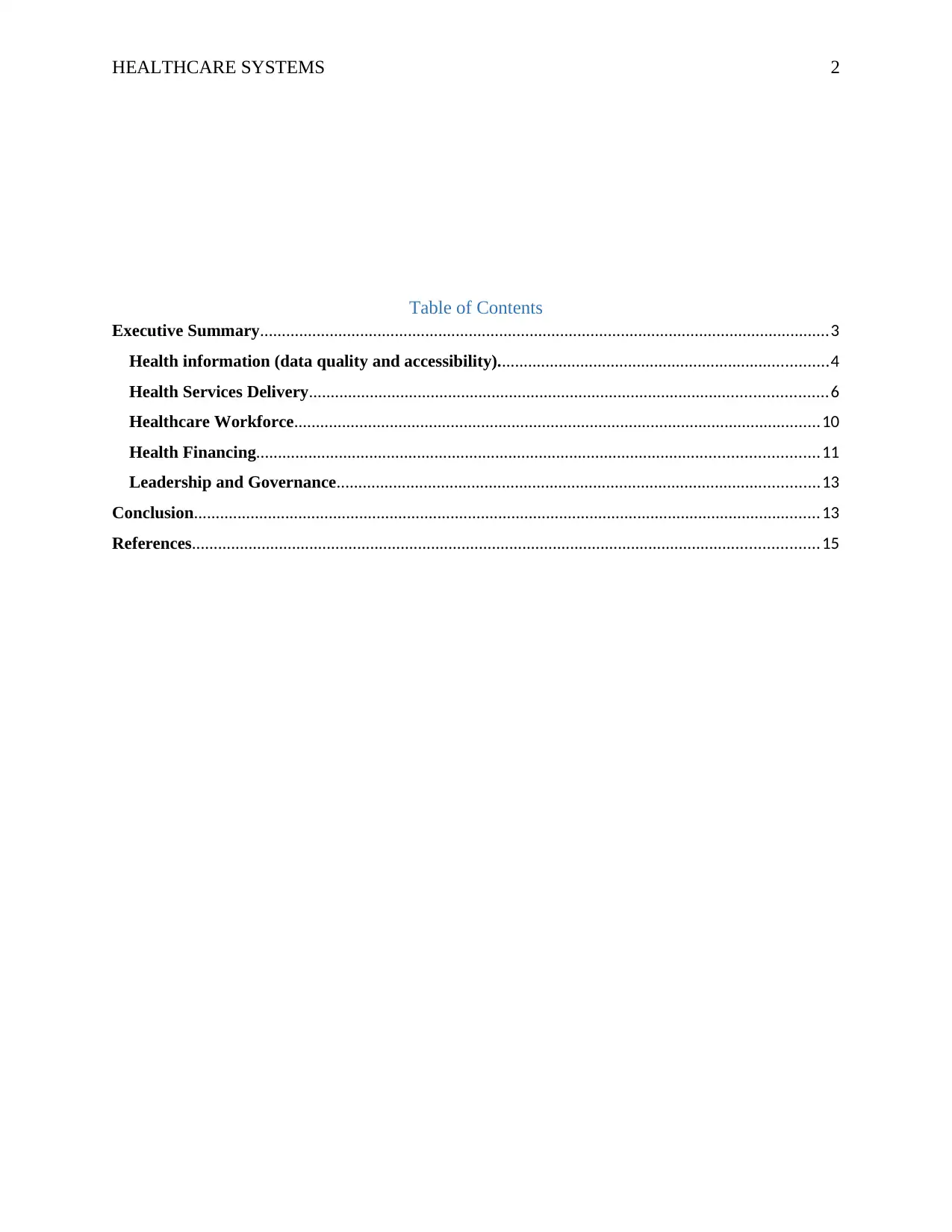
HEALTHCARE SYSTEMS 2
Table of Contents
Executive Summary...................................................................................................................................3
Health information (data quality and accessibility)............................................................................4
Health Services Delivery.......................................................................................................................6
Healthcare Workforce.........................................................................................................................10
Health Financing.................................................................................................................................11
Leadership and Governance...............................................................................................................13
Conclusion................................................................................................................................................13
References................................................................................................................................................15
Table of Contents
Executive Summary...................................................................................................................................3
Health information (data quality and accessibility)............................................................................4
Health Services Delivery.......................................................................................................................6
Healthcare Workforce.........................................................................................................................10
Health Financing.................................................................................................................................11
Leadership and Governance...............................................................................................................13
Conclusion................................................................................................................................................13
References................................................................................................................................................15
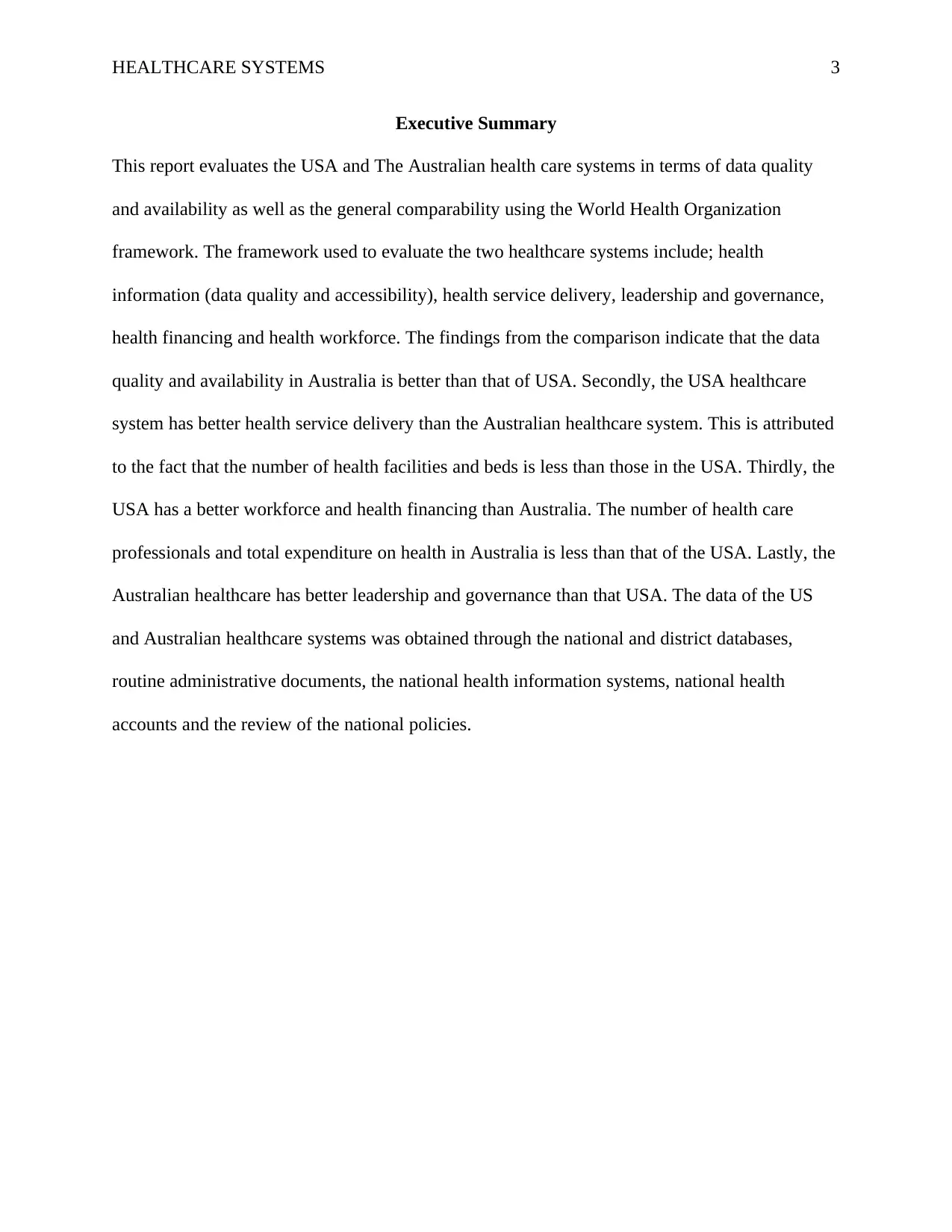
HEALTHCARE SYSTEMS 3
Executive Summary
This report evaluates the USA and The Australian health care systems in terms of data quality
and availability as well as the general comparability using the World Health Organization
framework. The framework used to evaluate the two healthcare systems include; health
information (data quality and accessibility), health service delivery, leadership and governance,
health financing and health workforce. The findings from the comparison indicate that the data
quality and availability in Australia is better than that of USA. Secondly, the USA healthcare
system has better health service delivery than the Australian healthcare system. This is attributed
to the fact that the number of health facilities and beds is less than those in the USA. Thirdly, the
USA has a better workforce and health financing than Australia. The number of health care
professionals and total expenditure on health in Australia is less than that of the USA. Lastly, the
Australian healthcare has better leadership and governance than that USA. The data of the US
and Australian healthcare systems was obtained through the national and district databases,
routine administrative documents, the national health information systems, national health
accounts and the review of the national policies.
Executive Summary
This report evaluates the USA and The Australian health care systems in terms of data quality
and availability as well as the general comparability using the World Health Organization
framework. The framework used to evaluate the two healthcare systems include; health
information (data quality and accessibility), health service delivery, leadership and governance,
health financing and health workforce. The findings from the comparison indicate that the data
quality and availability in Australia is better than that of USA. Secondly, the USA healthcare
system has better health service delivery than the Australian healthcare system. This is attributed
to the fact that the number of health facilities and beds is less than those in the USA. Thirdly, the
USA has a better workforce and health financing than Australia. The number of health care
professionals and total expenditure on health in Australia is less than that of the USA. Lastly, the
Australian healthcare has better leadership and governance than that USA. The data of the US
and Australian healthcare systems was obtained through the national and district databases,
routine administrative documents, the national health information systems, national health
accounts and the review of the national policies.
⊘ This is a preview!⊘
Do you want full access?
Subscribe today to unlock all pages.

Trusted by 1+ million students worldwide

HEALTHCARE SYSTEMS 4
Introduction
Comparing the healthcare systems of countries play a crucial role in ensuring that they
improve their performance. I have chosen include the USA and Australian health care system
where the two will be compared in terms of data quality and availability and the general
comparability of the systems using the World Health Organization framework. The frameworks
used include health service delivery, health workforce, health information (data quality and
accessibility), health financing and leadership and governance.
Health information (data quality and accessibility).
According to the World Health Organization (2010), each healthcare system should
ensure that healthcare data is accessible and of high quality. Regarding health information, the
Australian health care system is more efficient compared to the USA. For instance, the
Australian healthcare system addresses important health issues affecting specific population
groups in a way that ensures valid estimate of statistical data, as well as comparisons, to help
detect the similarities, patterns and differences. Secondly, the healthcare system ensures that the
health information generated is used to respond to and guide health policies and activities.
Thirdly, they system also ensures that the data collected is accurate, valid and reliable to the
extent that the data can be compared across time and place (Department of Health & Human
Services, 2015).
Fourthly, the system also ensures that there is ease in the collection of data in a way that
neither the healthcare system nor the healthcare professionals are burdened by the cost of
collecting data. Both the administrative and clinical data are collected frequently in hospitals.
The system also ensures that the feedback on the data collected is routinely collected from the
Introduction
Comparing the healthcare systems of countries play a crucial role in ensuring that they
improve their performance. I have chosen include the USA and Australian health care system
where the two will be compared in terms of data quality and availability and the general
comparability of the systems using the World Health Organization framework. The frameworks
used include health service delivery, health workforce, health information (data quality and
accessibility), health financing and leadership and governance.
Health information (data quality and accessibility).
According to the World Health Organization (2010), each healthcare system should
ensure that healthcare data is accessible and of high quality. Regarding health information, the
Australian health care system is more efficient compared to the USA. For instance, the
Australian healthcare system addresses important health issues affecting specific population
groups in a way that ensures valid estimate of statistical data, as well as comparisons, to help
detect the similarities, patterns and differences. Secondly, the healthcare system ensures that the
health information generated is used to respond to and guide health policies and activities.
Thirdly, they system also ensures that the data collected is accurate, valid and reliable to the
extent that the data can be compared across time and place (Department of Health & Human
Services, 2015).
Fourthly, the system also ensures that there is ease in the collection of data in a way that
neither the healthcare system nor the healthcare professionals are burdened by the cost of
collecting data. Both the administrative and clinical data are collected frequently in hospitals.
The system also ensures that the feedback on the data collected is routinely collected from the
Paraphrase This Document
Need a fresh take? Get an instant paraphrase of this document with our AI Paraphraser
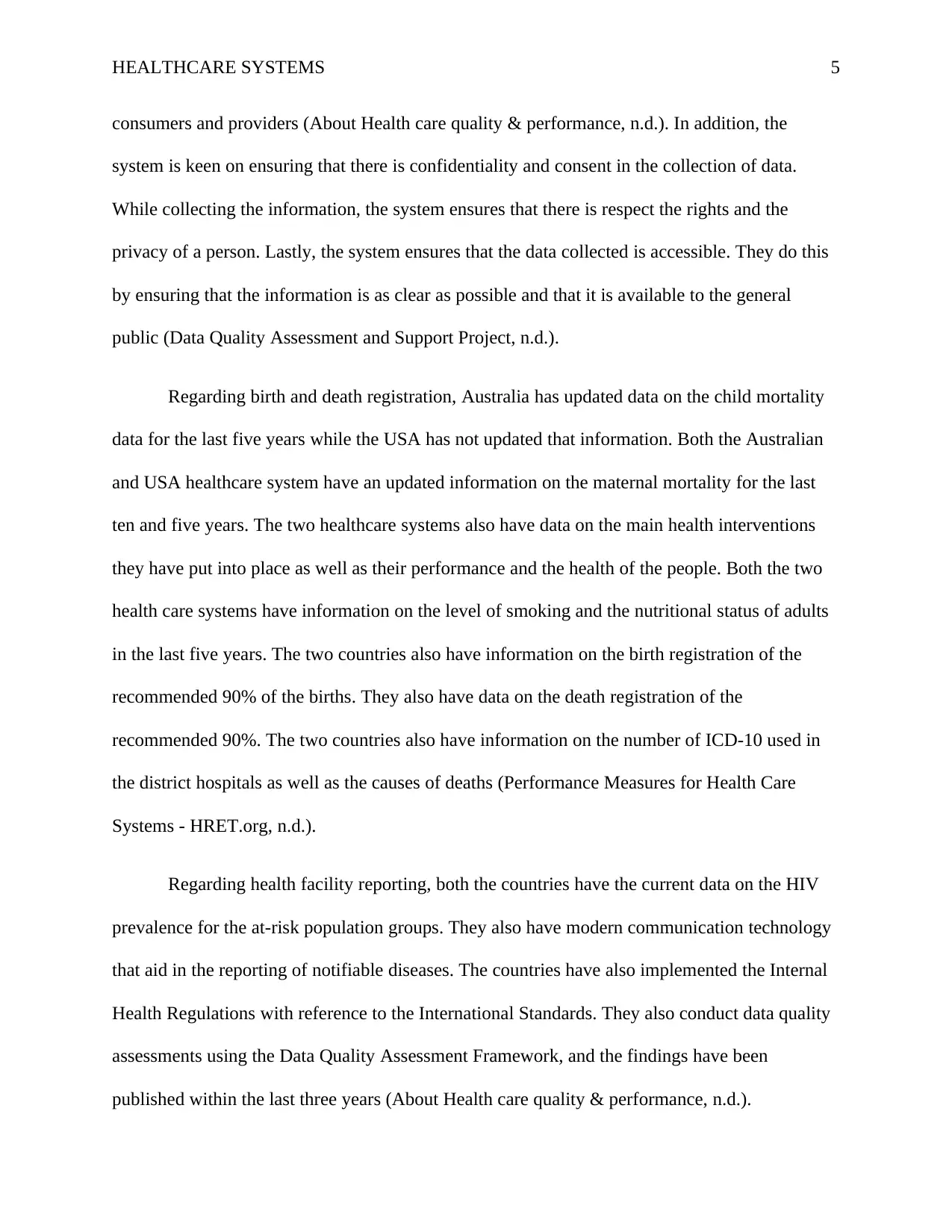
HEALTHCARE SYSTEMS 5
consumers and providers (About Health care quality & performance, n.d.). In addition, the
system is keen on ensuring that there is confidentiality and consent in the collection of data.
While collecting the information, the system ensures that there is respect the rights and the
privacy of a person. Lastly, the system ensures that the data collected is accessible. They do this
by ensuring that the information is as clear as possible and that it is available to the general
public (Data Quality Assessment and Support Project, n.d.).
Regarding birth and death registration, Australia has updated data on the child mortality
data for the last five years while the USA has not updated that information. Both the Australian
and USA healthcare system have an updated information on the maternal mortality for the last
ten and five years. The two healthcare systems also have data on the main health interventions
they have put into place as well as their performance and the health of the people. Both the two
health care systems have information on the level of smoking and the nutritional status of adults
in the last five years. The two countries also have information on the birth registration of the
recommended 90% of the births. They also have data on the death registration of the
recommended 90%. The two countries also have information on the number of ICD-10 used in
the district hospitals as well as the causes of deaths (Performance Measures for Health Care
Systems - HRET.org, n.d.).
Regarding health facility reporting, both the countries have the current data on the HIV
prevalence for the at-risk population groups. They also have modern communication technology
that aid in the reporting of notifiable diseases. The countries have also implemented the Internal
Health Regulations with reference to the International Standards. They also conduct data quality
assessments using the Data Quality Assessment Framework, and the findings have been
published within the last three years (About Health care quality & performance, n.d.).
consumers and providers (About Health care quality & performance, n.d.). In addition, the
system is keen on ensuring that there is confidentiality and consent in the collection of data.
While collecting the information, the system ensures that there is respect the rights and the
privacy of a person. Lastly, the system ensures that the data collected is accessible. They do this
by ensuring that the information is as clear as possible and that it is available to the general
public (Data Quality Assessment and Support Project, n.d.).
Regarding birth and death registration, Australia has updated data on the child mortality
data for the last five years while the USA has not updated that information. Both the Australian
and USA healthcare system have an updated information on the maternal mortality for the last
ten and five years. The two healthcare systems also have data on the main health interventions
they have put into place as well as their performance and the health of the people. Both the two
health care systems have information on the level of smoking and the nutritional status of adults
in the last five years. The two countries also have information on the birth registration of the
recommended 90% of the births. They also have data on the death registration of the
recommended 90%. The two countries also have information on the number of ICD-10 used in
the district hospitals as well as the causes of deaths (Performance Measures for Health Care
Systems - HRET.org, n.d.).
Regarding health facility reporting, both the countries have the current data on the HIV
prevalence for the at-risk population groups. They also have modern communication technology
that aid in the reporting of notifiable diseases. The countries have also implemented the Internal
Health Regulations with reference to the International Standards. They also conduct data quality
assessments using the Data Quality Assessment Framework, and the findings have been
published within the last three years (About Health care quality & performance, n.d.).
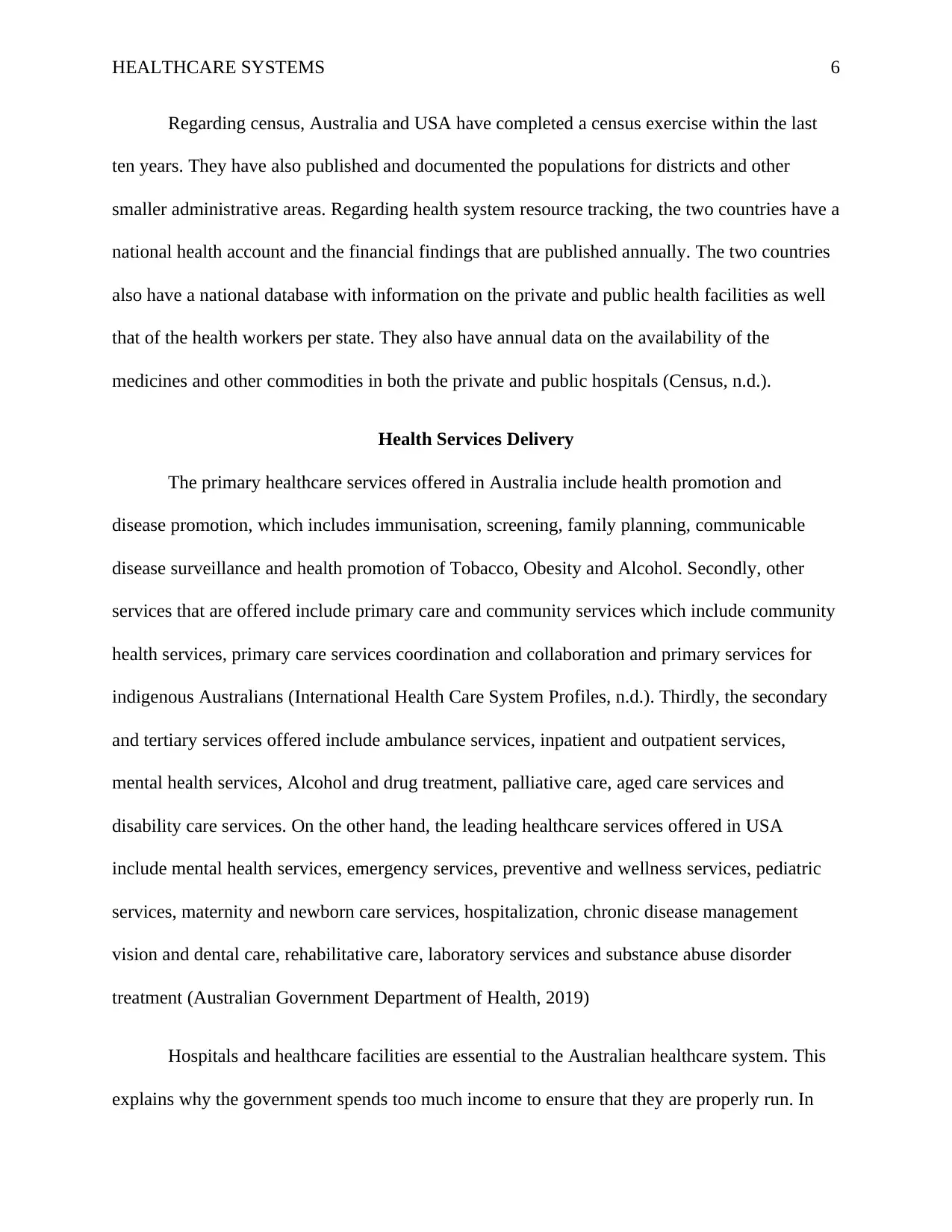
HEALTHCARE SYSTEMS 6
Regarding census, Australia and USA have completed a census exercise within the last
ten years. They have also published and documented the populations for districts and other
smaller administrative areas. Regarding health system resource tracking, the two countries have a
national health account and the financial findings that are published annually. The two countries
also have a national database with information on the private and public health facilities as well
that of the health workers per state. They also have annual data on the availability of the
medicines and other commodities in both the private and public hospitals (Census, n.d.).
Health Services Delivery
The primary healthcare services offered in Australia include health promotion and
disease promotion, which includes immunisation, screening, family planning, communicable
disease surveillance and health promotion of Tobacco, Obesity and Alcohol. Secondly, other
services that are offered include primary care and community services which include community
health services, primary care services coordination and collaboration and primary services for
indigenous Australians (International Health Care System Profiles, n.d.). Thirdly, the secondary
and tertiary services offered include ambulance services, inpatient and outpatient services,
mental health services, Alcohol and drug treatment, palliative care, aged care services and
disability care services. On the other hand, the leading healthcare services offered in USA
include mental health services, emergency services, preventive and wellness services, pediatric
services, maternity and newborn care services, hospitalization, chronic disease management
vision and dental care, rehabilitative care, laboratory services and substance abuse disorder
treatment (Australian Government Department of Health, 2019)
Hospitals and healthcare facilities are essential to the Australian healthcare system. This
explains why the government spends too much income to ensure that they are properly run. In
Regarding census, Australia and USA have completed a census exercise within the last
ten years. They have also published and documented the populations for districts and other
smaller administrative areas. Regarding health system resource tracking, the two countries have a
national health account and the financial findings that are published annually. The two countries
also have a national database with information on the private and public health facilities as well
that of the health workers per state. They also have annual data on the availability of the
medicines and other commodities in both the private and public hospitals (Census, n.d.).
Health Services Delivery
The primary healthcare services offered in Australia include health promotion and
disease promotion, which includes immunisation, screening, family planning, communicable
disease surveillance and health promotion of Tobacco, Obesity and Alcohol. Secondly, other
services that are offered include primary care and community services which include community
health services, primary care services coordination and collaboration and primary services for
indigenous Australians (International Health Care System Profiles, n.d.). Thirdly, the secondary
and tertiary services offered include ambulance services, inpatient and outpatient services,
mental health services, Alcohol and drug treatment, palliative care, aged care services and
disability care services. On the other hand, the leading healthcare services offered in USA
include mental health services, emergency services, preventive and wellness services, pediatric
services, maternity and newborn care services, hospitalization, chronic disease management
vision and dental care, rehabilitative care, laboratory services and substance abuse disorder
treatment (Australian Government Department of Health, 2019)
Hospitals and healthcare facilities are essential to the Australian healthcare system. This
explains why the government spends too much income to ensure that they are properly run. In
⊘ This is a preview!⊘
Do you want full access?
Subscribe today to unlock all pages.

Trusted by 1+ million students worldwide
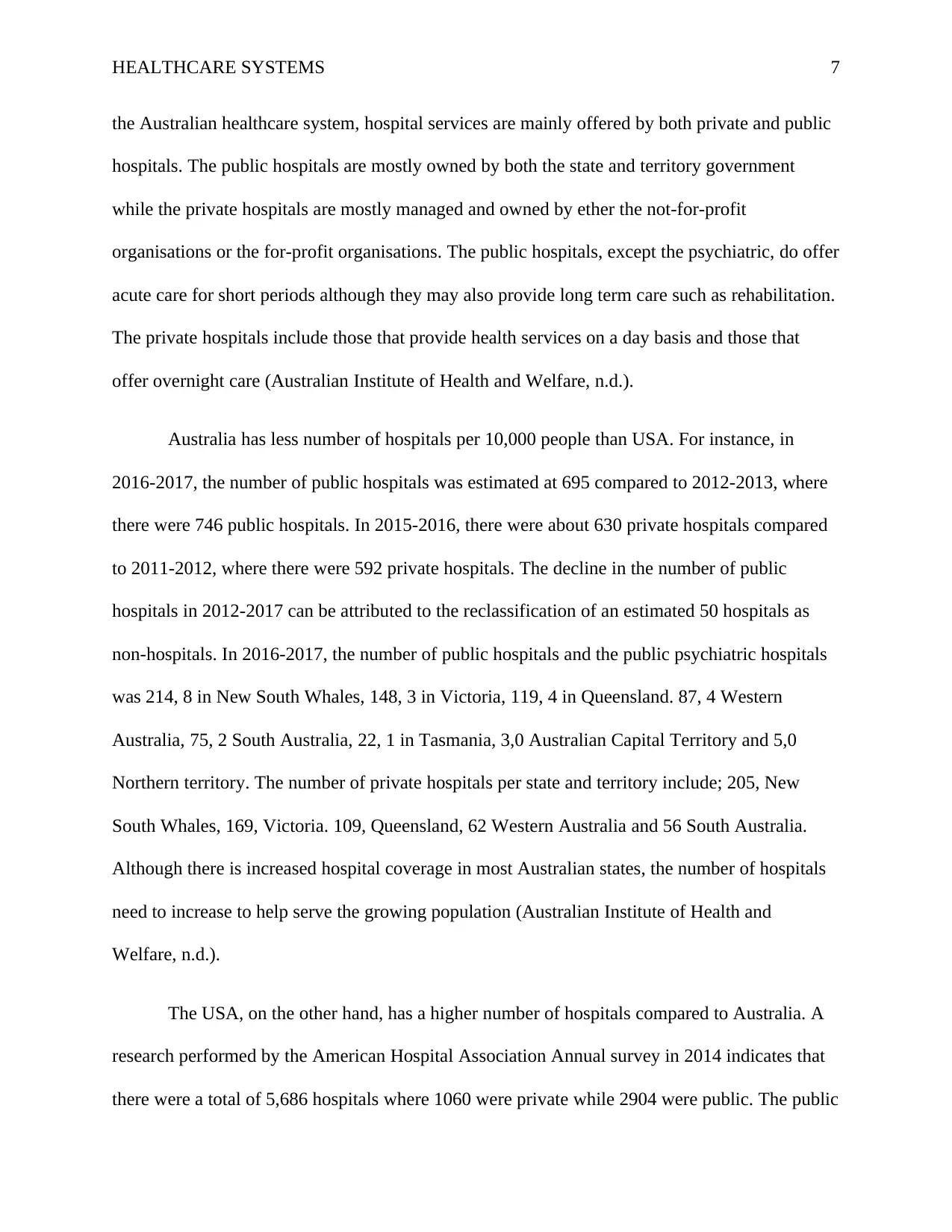
HEALTHCARE SYSTEMS 7
the Australian healthcare system, hospital services are mainly offered by both private and public
hospitals. The public hospitals are mostly owned by both the state and territory government
while the private hospitals are mostly managed and owned by ether the not-for-profit
organisations or the for-profit organisations. The public hospitals, except the psychiatric, do offer
acute care for short periods although they may also provide long term care such as rehabilitation.
The private hospitals include those that provide health services on a day basis and those that
offer overnight care (Australian Institute of Health and Welfare, n.d.).
Australia has less number of hospitals per 10,000 people than USA. For instance, in
2016-2017, the number of public hospitals was estimated at 695 compared to 2012-2013, where
there were 746 public hospitals. In 2015-2016, there were about 630 private hospitals compared
to 2011-2012, where there were 592 private hospitals. The decline in the number of public
hospitals in 2012-2017 can be attributed to the reclassification of an estimated 50 hospitals as
non-hospitals. In 2016-2017, the number of public hospitals and the public psychiatric hospitals
was 214, 8 in New South Whales, 148, 3 in Victoria, 119, 4 in Queensland. 87, 4 Western
Australia, 75, 2 South Australia, 22, 1 in Tasmania, 3,0 Australian Capital Territory and 5,0
Northern territory. The number of private hospitals per state and territory include; 205, New
South Whales, 169, Victoria. 109, Queensland, 62 Western Australia and 56 South Australia.
Although there is increased hospital coverage in most Australian states, the number of hospitals
need to increase to help serve the growing population (Australian Institute of Health and
Welfare, n.d.).
The USA, on the other hand, has a higher number of hospitals compared to Australia. A
research performed by the American Hospital Association Annual survey in 2014 indicates that
there were a total of 5,686 hospitals where 1060 were private while 2904 were public. The public
the Australian healthcare system, hospital services are mainly offered by both private and public
hospitals. The public hospitals are mostly owned by both the state and territory government
while the private hospitals are mostly managed and owned by ether the not-for-profit
organisations or the for-profit organisations. The public hospitals, except the psychiatric, do offer
acute care for short periods although they may also provide long term care such as rehabilitation.
The private hospitals include those that provide health services on a day basis and those that
offer overnight care (Australian Institute of Health and Welfare, n.d.).
Australia has less number of hospitals per 10,000 people than USA. For instance, in
2016-2017, the number of public hospitals was estimated at 695 compared to 2012-2013, where
there were 746 public hospitals. In 2015-2016, there were about 630 private hospitals compared
to 2011-2012, where there were 592 private hospitals. The decline in the number of public
hospitals in 2012-2017 can be attributed to the reclassification of an estimated 50 hospitals as
non-hospitals. In 2016-2017, the number of public hospitals and the public psychiatric hospitals
was 214, 8 in New South Whales, 148, 3 in Victoria, 119, 4 in Queensland. 87, 4 Western
Australia, 75, 2 South Australia, 22, 1 in Tasmania, 3,0 Australian Capital Territory and 5,0
Northern territory. The number of private hospitals per state and territory include; 205, New
South Whales, 169, Victoria. 109, Queensland, 62 Western Australia and 56 South Australia.
Although there is increased hospital coverage in most Australian states, the number of hospitals
need to increase to help serve the growing population (Australian Institute of Health and
Welfare, n.d.).
The USA, on the other hand, has a higher number of hospitals compared to Australia. A
research performed by the American Hospital Association Annual survey in 2014 indicates that
there were a total of 5,686 hospitals where 1060 were private while 2904 were public. The public
Paraphrase This Document
Need a fresh take? Get an instant paraphrase of this document with our AI Paraphraser

HEALTHCARE SYSTEMS 8
hospitals had about 795,603 hospital beds while the private hospitals had 118,910 hospital beds.
A research conducted in 2019 indicates that there are about 6210 hospitals. There are 208 federal
government hospitals, 2968, non-government not-for-profit hospitals, 1322 for-profit hospitals,
972 state and local government hospitals and 620 non -federal psychiatric hospitals. The number
of hospital beds is estimated at 798,921. The high number of hospitals indicates that there is
improved access to healthcare services in (Australia Fast Facts on U.S. Hospitals, 2019 | AHA,
n.d.).
Although there is an improvement in the number of hospital beds in Australia, the
country has failed to reach the standards of the number of beds per 10,000 people. The number
of beds in public hospitals in Australia in 2016-2017 includes 62,000, which is a 1.5% increase
from 58,300. This shows that despite the decrease in the number of public hospitals, there was an
increase in the number of beds. There were about 2.5 beds per 1000 patients. There were about
42,000 beds in the major cities in Australia while there were about 1800 hospital beds in the
remote areas of the country. This shows that most of the beds were present in bigger hospitals
that served the densely populated areas. In 2011-2012 and 2015-2016, the number of hospital
beds in private hospitals increased from 29,000 to 33,100, which is about 3.3% increase
annually. There were an estimated 1.4 beds for every 1000 people. The decrease in the number
of hospital beds is associated with decreased utilisation of health services. As a result, this
adversely affects the health of the people (Australian Institute of Health and Welfare, n.d.).
Both the USA and Australia offers patient centred care where the healthcare professionals
are keen on addressing the health needs of a person and ensuring that they have the desired
health outcomes (Conway, Goodrich, Machlin, Sasse & Cohen, 2011). The healthcare providers
also put into consideration the mental, social, emotional and spiritual needs of the people. The
hospitals had about 795,603 hospital beds while the private hospitals had 118,910 hospital beds.
A research conducted in 2019 indicates that there are about 6210 hospitals. There are 208 federal
government hospitals, 2968, non-government not-for-profit hospitals, 1322 for-profit hospitals,
972 state and local government hospitals and 620 non -federal psychiatric hospitals. The number
of hospital beds is estimated at 798,921. The high number of hospitals indicates that there is
improved access to healthcare services in (Australia Fast Facts on U.S. Hospitals, 2019 | AHA,
n.d.).
Although there is an improvement in the number of hospital beds in Australia, the
country has failed to reach the standards of the number of beds per 10,000 people. The number
of beds in public hospitals in Australia in 2016-2017 includes 62,000, which is a 1.5% increase
from 58,300. This shows that despite the decrease in the number of public hospitals, there was an
increase in the number of beds. There were about 2.5 beds per 1000 patients. There were about
42,000 beds in the major cities in Australia while there were about 1800 hospital beds in the
remote areas of the country. This shows that most of the beds were present in bigger hospitals
that served the densely populated areas. In 2011-2012 and 2015-2016, the number of hospital
beds in private hospitals increased from 29,000 to 33,100, which is about 3.3% increase
annually. There were an estimated 1.4 beds for every 1000 people. The decrease in the number
of hospital beds is associated with decreased utilisation of health services. As a result, this
adversely affects the health of the people (Australian Institute of Health and Welfare, n.d.).
Both the USA and Australia offers patient centred care where the healthcare professionals
are keen on addressing the health needs of a person and ensuring that they have the desired
health outcomes (Conway, Goodrich, Machlin, Sasse & Cohen, 2011). The healthcare providers
also put into consideration the mental, social, emotional and spiritual needs of the people. The

HEALTHCARE SYSTEMS 9
Australian healthcare system is keen on ensuring that there is the provision of quality healthcare
(Patient-centered care as an approach to improving health care in Australia, 2017). For instance,
the system ensures that there are the monitoring and reporting of safety and quality measures to
support the healthcare professionals in ensuring quality and safety of care. The Australian
Commission on Safety and Quality and other organisations provide leadership to the
professionals by reporting information regarding safety and quality care (Improving Quality and
Safety, n.d.). Some of the information the commission reports includes healthcare-associated
infections, patient experience, and hospital-acquired diagnosis, adverse events treated in the
hospitals and unplanned hospital admission rates (Commonwealth Parliament, & Parliament
House, 2017).
Australia provides quality care compared to the USA. Although the USA is keen on
providing quality care, it has failed to achieve this. A research performed by the Institute of
Medicine shows that preventable medical errors in the USA led to about 44,000-98000 deaths
annually. The study also found out that the health services provided were not safe (How does the
quality of the U.S. healthcare system compare to other countries, n.d.). A study conducted in
2016 shows that the number of medical, lab and medication errors in the USA was 19% while
that of Australia was 11%. The study also shows that patients in the USA are more likely to
experience a medical error compared to Australia. Poor quality care in the USA is related to an
increase in health costs. It is also related to impairment, long term disability and lost
productivity, which leads to the loss of trillions annually (How does the quality of the U.S.
healthcare system compare to other countries, n.d.).
Both the USA and Australia healthcare systems have focused on ensuring that their
medical students receive quality education to ensure that can deliver quality services after their
Australian healthcare system is keen on ensuring that there is the provision of quality healthcare
(Patient-centered care as an approach to improving health care in Australia, 2017). For instance,
the system ensures that there are the monitoring and reporting of safety and quality measures to
support the healthcare professionals in ensuring quality and safety of care. The Australian
Commission on Safety and Quality and other organisations provide leadership to the
professionals by reporting information regarding safety and quality care (Improving Quality and
Safety, n.d.). Some of the information the commission reports includes healthcare-associated
infections, patient experience, and hospital-acquired diagnosis, adverse events treated in the
hospitals and unplanned hospital admission rates (Commonwealth Parliament, & Parliament
House, 2017).
Australia provides quality care compared to the USA. Although the USA is keen on
providing quality care, it has failed to achieve this. A research performed by the Institute of
Medicine shows that preventable medical errors in the USA led to about 44,000-98000 deaths
annually. The study also found out that the health services provided were not safe (How does the
quality of the U.S. healthcare system compare to other countries, n.d.). A study conducted in
2016 shows that the number of medical, lab and medication errors in the USA was 19% while
that of Australia was 11%. The study also shows that patients in the USA are more likely to
experience a medical error compared to Australia. Poor quality care in the USA is related to an
increase in health costs. It is also related to impairment, long term disability and lost
productivity, which leads to the loss of trillions annually (How does the quality of the U.S.
healthcare system compare to other countries, n.d.).
Both the USA and Australia healthcare systems have focused on ensuring that their
medical students receive quality education to ensure that can deliver quality services after their
⊘ This is a preview!⊘
Do you want full access?
Subscribe today to unlock all pages.

Trusted by 1+ million students worldwide
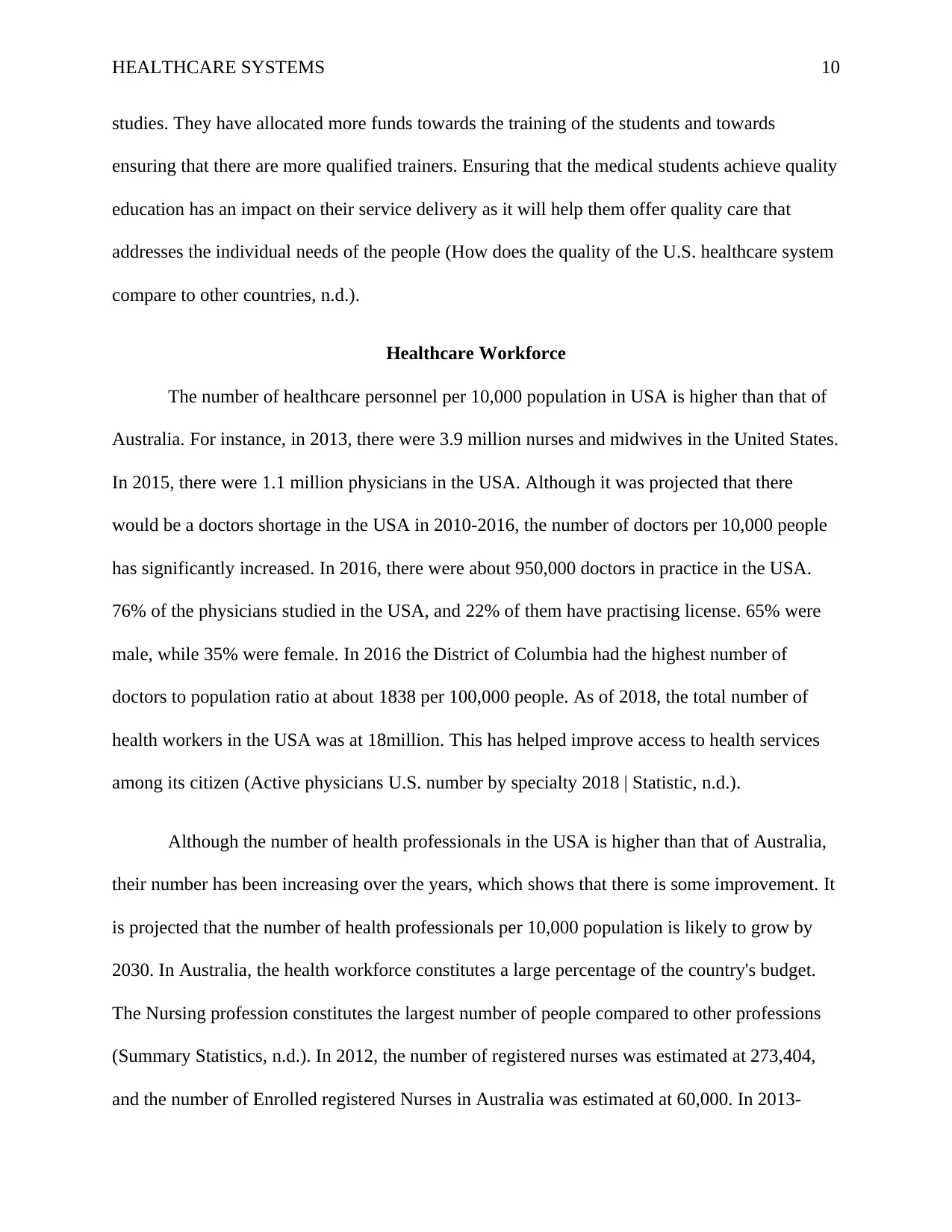
HEALTHCARE SYSTEMS 10
studies. They have allocated more funds towards the training of the students and towards
ensuring that there are more qualified trainers. Ensuring that the medical students achieve quality
education has an impact on their service delivery as it will help them offer quality care that
addresses the individual needs of the people (How does the quality of the U.S. healthcare system
compare to other countries, n.d.).
Healthcare Workforce
The number of healthcare personnel per 10,000 population in USA is higher than that of
Australia. For instance, in 2013, there were 3.9 million nurses and midwives in the United States.
In 2015, there were 1.1 million physicians in the USA. Although it was projected that there
would be a doctors shortage in the USA in 2010-2016, the number of doctors per 10,000 people
has significantly increased. In 2016, there were about 950,000 doctors in practice in the USA.
76% of the physicians studied in the USA, and 22% of them have practising license. 65% were
male, while 35% were female. In 2016 the District of Columbia had the highest number of
doctors to population ratio at about 1838 per 100,000 people. As of 2018, the total number of
health workers in the USA was at 18million. This has helped improve access to health services
among its citizen (Active physicians U.S. number by specialty 2018 | Statistic, n.d.).
Although the number of health professionals in the USA is higher than that of Australia,
their number has been increasing over the years, which shows that there is some improvement. It
is projected that the number of health professionals per 10,000 population is likely to grow by
2030. In Australia, the health workforce constitutes a large percentage of the country's budget.
The Nursing profession constitutes the largest number of people compared to other professions
(Summary Statistics, n.d.). In 2012, the number of registered nurses was estimated at 273,404,
and the number of Enrolled registered Nurses in Australia was estimated at 60,000. In 2013-
studies. They have allocated more funds towards the training of the students and towards
ensuring that there are more qualified trainers. Ensuring that the medical students achieve quality
education has an impact on their service delivery as it will help them offer quality care that
addresses the individual needs of the people (How does the quality of the U.S. healthcare system
compare to other countries, n.d.).
Healthcare Workforce
The number of healthcare personnel per 10,000 population in USA is higher than that of
Australia. For instance, in 2013, there were 3.9 million nurses and midwives in the United States.
In 2015, there were 1.1 million physicians in the USA. Although it was projected that there
would be a doctors shortage in the USA in 2010-2016, the number of doctors per 10,000 people
has significantly increased. In 2016, there were about 950,000 doctors in practice in the USA.
76% of the physicians studied in the USA, and 22% of them have practising license. 65% were
male, while 35% were female. In 2016 the District of Columbia had the highest number of
doctors to population ratio at about 1838 per 100,000 people. As of 2018, the total number of
health workers in the USA was at 18million. This has helped improve access to health services
among its citizen (Active physicians U.S. number by specialty 2018 | Statistic, n.d.).
Although the number of health professionals in the USA is higher than that of Australia,
their number has been increasing over the years, which shows that there is some improvement. It
is projected that the number of health professionals per 10,000 population is likely to grow by
2030. In Australia, the health workforce constitutes a large percentage of the country's budget.
The Nursing profession constitutes the largest number of people compared to other professions
(Summary Statistics, n.d.). In 2012, the number of registered nurses was estimated at 273,404,
and the number of Enrolled registered Nurses in Australia was estimated at 60,000. In 2013-
Paraphrase This Document
Need a fresh take? Get an instant paraphrase of this document with our AI Paraphraser

HEALTHCARE SYSTEMS 11
2016, there was a 4% increase in the number of Registered Nurses and midwives where their
number rose to 369,790 from 344,190. Among these, 315,137 were employed, which is an
increase from 295,177 (Australian Institute of Health and Welfare, n.d.).
The number of registered medical practitioners increased from 91,472 to 101,070, which
is a 10.5% increase. Among these, 91,341 were employed, which is an increase of 10.8% from
2013s' 82,408. The number of registered psychologists increased from 26,725 to 29163, which is
a 9.1% increase. There was an increase in the number of employed psychologists from 23,089 in
2013 to 25,213 in 2016, which is a 9.2% increase. The number of physiotherapists increased
from 25,545 to 29, 591, which is a 15.8% increase. The number of employed physiotherapists
increased by 15.2% that is from 21,052 in 2013 to 21,255 in 2016. The number of dentists
increased from 15,479 to 16,549, which is a 6.9% increase. The number of employed dentists
increased by 8.4% (Australian Institute of Health and Welfare, n.d.).
Both Australia and the USA have also focused on training more health workers to ensure
that there is an adequate number of the healthcare workforce. For instance, the enrollment of the
students to the medical school in the USA has increased by about 28% from 2002-2017. In 2016-
2017 the number of enrolled students was estimated at 21,030. There has also been an increase in
the number of accredited medical schools from 2002. These medical schools account for the 40%
increase in enrollment growth (U.S. Medical School Enrollment Up 28% since 2002, 2017).
Health Financing
Although the total expenditure on health in Australia is lower than that of the USA, it
keeps increasing anually. For instance, in 2011-2012, the total expenditure of healthcare in
Australia was estimated at $140.2 billion. 69.7% of this was funded by the government whereby
2016, there was a 4% increase in the number of Registered Nurses and midwives where their
number rose to 369,790 from 344,190. Among these, 315,137 were employed, which is an
increase from 295,177 (Australian Institute of Health and Welfare, n.d.).
The number of registered medical practitioners increased from 91,472 to 101,070, which
is a 10.5% increase. Among these, 91,341 were employed, which is an increase of 10.8% from
2013s' 82,408. The number of registered psychologists increased from 26,725 to 29163, which is
a 9.1% increase. There was an increase in the number of employed psychologists from 23,089 in
2013 to 25,213 in 2016, which is a 9.2% increase. The number of physiotherapists increased
from 25,545 to 29, 591, which is a 15.8% increase. The number of employed physiotherapists
increased by 15.2% that is from 21,052 in 2013 to 21,255 in 2016. The number of dentists
increased from 15,479 to 16,549, which is a 6.9% increase. The number of employed dentists
increased by 8.4% (Australian Institute of Health and Welfare, n.d.).
Both Australia and the USA have also focused on training more health workers to ensure
that there is an adequate number of the healthcare workforce. For instance, the enrollment of the
students to the medical school in the USA has increased by about 28% from 2002-2017. In 2016-
2017 the number of enrolled students was estimated at 21,030. There has also been an increase in
the number of accredited medical schools from 2002. These medical schools account for the 40%
increase in enrollment growth (U.S. Medical School Enrollment Up 28% since 2002, 2017).
Health Financing
Although the total expenditure on health in Australia is lower than that of the USA, it
keeps increasing anually. For instance, in 2011-2012, the total expenditure of healthcare in
Australia was estimated at $140.2 billion. 69.7% of this was funded by the government whereby
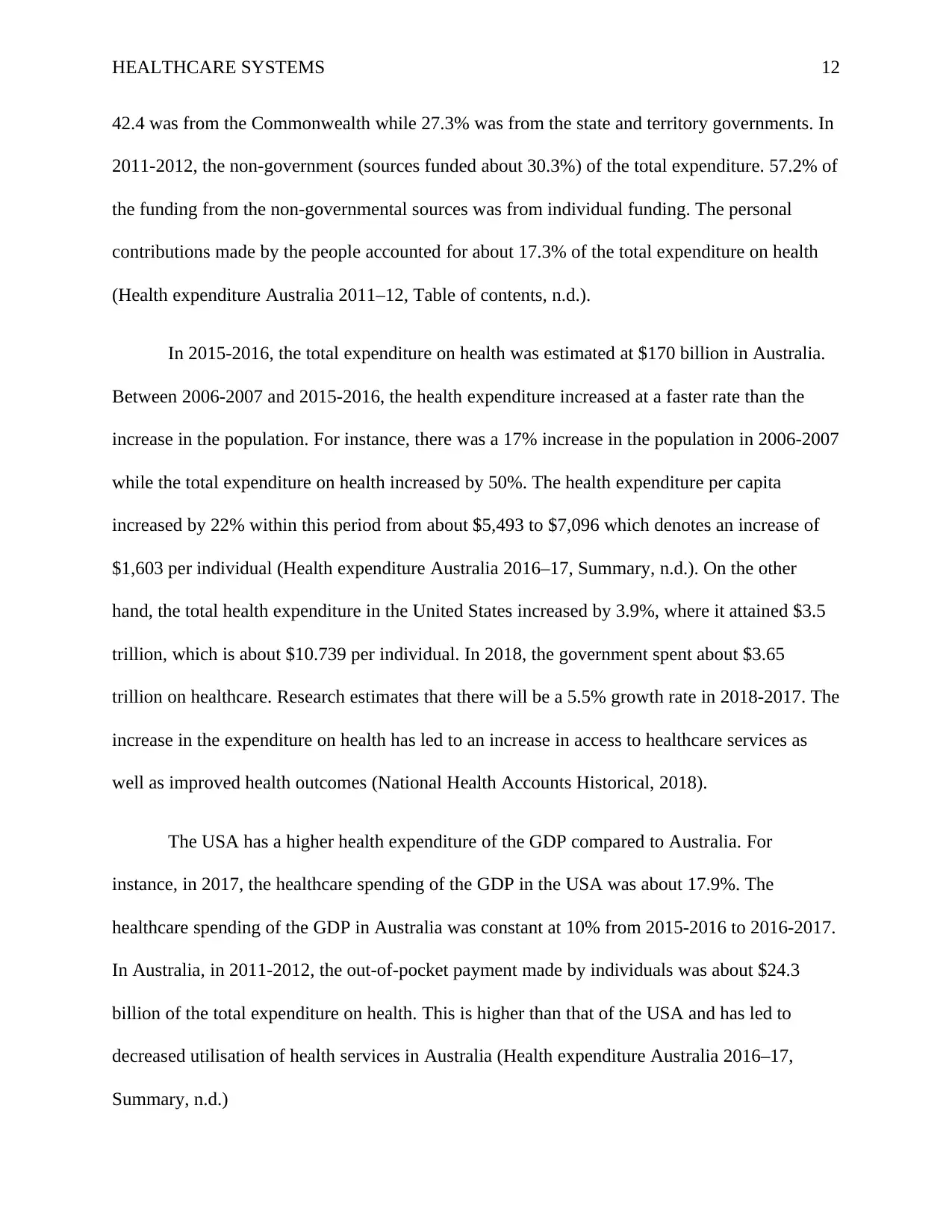
HEALTHCARE SYSTEMS 12
42.4 was from the Commonwealth while 27.3% was from the state and territory governments. In
2011-2012, the non-government (sources funded about 30.3%) of the total expenditure. 57.2% of
the funding from the non-governmental sources was from individual funding. The personal
contributions made by the people accounted for about 17.3% of the total expenditure on health
(Health expenditure Australia 2011–12, Table of contents, n.d.).
In 2015-2016, the total expenditure on health was estimated at $170 billion in Australia.
Between 2006-2007 and 2015-2016, the health expenditure increased at a faster rate than the
increase in the population. For instance, there was a 17% increase in the population in 2006-2007
while the total expenditure on health increased by 50%. The health expenditure per capita
increased by 22% within this period from about $5,493 to $7,096 which denotes an increase of
$1,603 per individual (Health expenditure Australia 2016–17, Summary, n.d.). On the other
hand, the total health expenditure in the United States increased by 3.9%, where it attained $3.5
trillion, which is about $10.739 per individual. In 2018, the government spent about $3.65
trillion on healthcare. Research estimates that there will be a 5.5% growth rate in 2018-2017. The
increase in the expenditure on health has led to an increase in access to healthcare services as
well as improved health outcomes (National Health Accounts Historical, 2018).
The USA has a higher health expenditure of the GDP compared to Australia. For
instance, in 2017, the healthcare spending of the GDP in the USA was about 17.9%. The
healthcare spending of the GDP in Australia was constant at 10% from 2015-2016 to 2016-2017.
In Australia, in 2011-2012, the out-of-pocket payment made by individuals was about $24.3
billion of the total expenditure on health. This is higher than that of the USA and has led to
decreased utilisation of health services in Australia (Health expenditure Australia 2016–17,
Summary, n.d.)
42.4 was from the Commonwealth while 27.3% was from the state and territory governments. In
2011-2012, the non-government (sources funded about 30.3%) of the total expenditure. 57.2% of
the funding from the non-governmental sources was from individual funding. The personal
contributions made by the people accounted for about 17.3% of the total expenditure on health
(Health expenditure Australia 2011–12, Table of contents, n.d.).
In 2015-2016, the total expenditure on health was estimated at $170 billion in Australia.
Between 2006-2007 and 2015-2016, the health expenditure increased at a faster rate than the
increase in the population. For instance, there was a 17% increase in the population in 2006-2007
while the total expenditure on health increased by 50%. The health expenditure per capita
increased by 22% within this period from about $5,493 to $7,096 which denotes an increase of
$1,603 per individual (Health expenditure Australia 2016–17, Summary, n.d.). On the other
hand, the total health expenditure in the United States increased by 3.9%, where it attained $3.5
trillion, which is about $10.739 per individual. In 2018, the government spent about $3.65
trillion on healthcare. Research estimates that there will be a 5.5% growth rate in 2018-2017. The
increase in the expenditure on health has led to an increase in access to healthcare services as
well as improved health outcomes (National Health Accounts Historical, 2018).
The USA has a higher health expenditure of the GDP compared to Australia. For
instance, in 2017, the healthcare spending of the GDP in the USA was about 17.9%. The
healthcare spending of the GDP in Australia was constant at 10% from 2015-2016 to 2016-2017.
In Australia, in 2011-2012, the out-of-pocket payment made by individuals was about $24.3
billion of the total expenditure on health. This is higher than that of the USA and has led to
decreased utilisation of health services in Australia (Health expenditure Australia 2016–17,
Summary, n.d.)
⊘ This is a preview!⊘
Do you want full access?
Subscribe today to unlock all pages.

Trusted by 1+ million students worldwide
1 out of 18
Related Documents
Your All-in-One AI-Powered Toolkit for Academic Success.
+13062052269
info@desklib.com
Available 24*7 on WhatsApp / Email
![[object Object]](/_next/static/media/star-bottom.7253800d.svg)
Unlock your academic potential
Copyright © 2020–2025 A2Z Services. All Rights Reserved. Developed and managed by ZUCOL.





